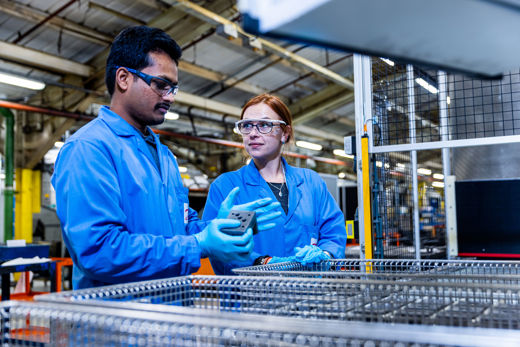
Our decarbonization activities span across the full value chain. As a leading provider of energy-efficiency solutions, Danfoss is an essential partner in the green transition and decrease of value chain emissions. Value chain emissions, also known as scope 3 emissions, are the most significant part of Danfoss’ total carbon footprint, comprising of more than 99%. These emissions occur outside of our operations – upstream with suppliers and downstream with the use of our products by our customers. We have set a stretch goal, going beyond our 15% science-based target, to reduce upstream scope 3 emissions by 25%.
The decarbonization levers for scope 3 are complex and often require innovation and partnerships along the value chain. We embrace this as an opportunity to collaborate with our business partners, suppliers, peers, and customers to achieve our shared goals of industry decarbonization.
Building robust emission data foundations
As part of our continued efforts to decarbonize our products and value chain, we are building the foundations for an effective data architecture. We are engaging with customers to identify their data needs and how we could support their sustainability journey. We have initiated several projects to further develop the consistency and transparency of sustainability data across functions, strengthening our internal processes and controls.
To deliver accurate and up-to-date information about our products’ use-phase emissions and the corresponding avoided emissions, we collect information from our upstream and downstream business partners.
In 2024, we refined our methodology for calculating emissions from purchased goods and services, focusing on collecting more primary data. We have continued to enhance our methodology and data improvements related to the use of sold product emissions.
Upstream emissions: Decarbonizing with our suppliers
Upstream emissions make up approximately 4% of our total carbon footprint. Our upstream decarbonization roadmaps include three key levers: low-carbon raw materials, circular economy strategies, and supplier commitments to decarbonization.
- Low-carbon raw materials: Aluminum, iron, and steel were selected to enhance our efforts on low-carbon production and increase recycled content as they comprise more than two-thirds of our upstream emissions.
- Circular economy: strategies such as design for disassembly and recycling, increased recycled content, and re-manufacturing were identified as important levers for decarbonizing our supply chain.
- Supplier commitments to decarbonization: We continue to work with sustainability data and performance improvements, rolled out to key suppliers. We engage with our supply chain partners to identify concrete opportunities for emissions savings. Through our supplier engagement program, the ‘Green Ask’ initiative, we have worked with our suppliers to improve greenhouse gas emission data, implement emissions reduction initiatives, and promote the sourcing of renewable energy. In 2024, we engage all our strategic suppliers in the program, covering more than 40% of our annual purchase spend. Most of them have established emission reduction targets.
Downstream emissions: Decarbonizing with our customers
Our downstream scope 3 emissions from the use of sold products account for around 96% of our total carbon footprint and amount to approximately 120 million tons annually. While the carbon intensity of the used energy decreases over time, we work to find ways to reduce the carbon footprint of our products, identifying levers to make them more energy efficient and optimize their use of energy. This calls for new solutions, ranging from business model innovation to product and market portfolio mix strategies. We also focus on establishing strong partnerships with customers to drive use-phase emissions down.
In 2024, we continued to mature our decarbonization roadmaps by working with decarbonization levers across three segments. A new innovation pipeline management process implemented for assessing projects with high decarbonization and commercial potential, enables us to identify and develop concrete decarbonization projects and opportunities proactively. In 2025, we will continue leveraging different levers to achieve our targets.

Research and development
Our product decarbonization strategy revolves around existing products as well as products in development. Given our products’ life cycle and the time from design to market entry, we identify short-term decarbonization levers while incorporating our climate targets into our long-term product development pipeline. As such we aim to integrate use-phase emissions as a key performance indicator in our product development toolbox. This will enable the development of a product pipeline consistent with our ambitious climate targets.
Avoided emissions
Avoided emissions are the measure of a company’s positive climate impact on society resulting from the use of its products and solutions. For Danfoss, our avoided emissions represent potential savings for our customers and end users of our products. Delivering this through energy efficiency improvements, low-carbon products and solutions, and enhanced electrification is at the core of our business.
In 2024, we finalized two third-party validated case studies on heat pumps and industrial fans. We are working on incorporating avoided emissions into our new product development processes to systematize their quantification. In 2025, we will publish our methodologies for avoided emissions in alignment with the World Business Council for Sustainable Development guidelines.
Our emissions baseline
We use the Greenhouse Gas (GHG) Protocol as the methodology for calculating our emissions. A detailed emission screening shows that the major contributor to our value chain emissions is the customers’ use of our products.
We have identified levers and mitigation activities for the reduction of GHG emissions in our value chain.
The Science Based Targets initiative (SBTi)
The SBTi supports companies in setting emission-reduction targets required to keep temperature increase below 2°C compared to pre-industrial temperatures.
The SBTi is a collaboration between the Carbon Disclosure Project (CDP), the United Nations Global Compact (UNGC), World Resources Institute (WRI), and the World Wide Fund for Nature (WWF).
The initiative’s overall aim is for businesses and corporations worldwide to use science-based targets as a fundamental component in their approach to sustainability.

